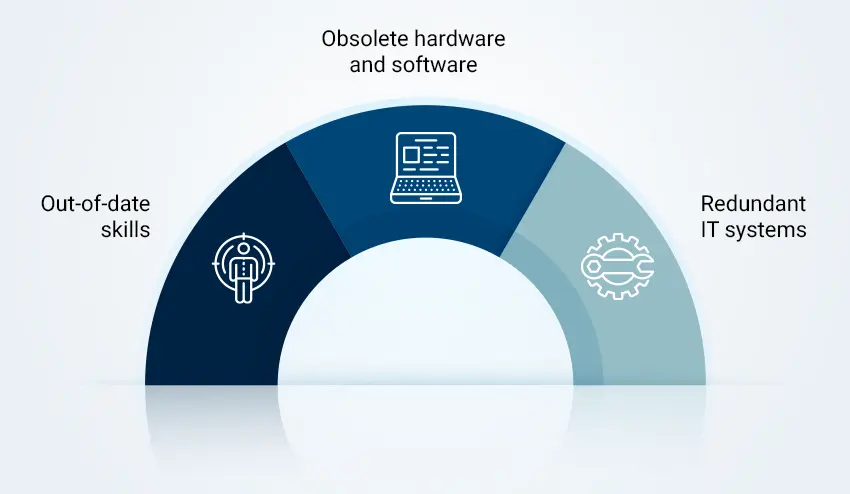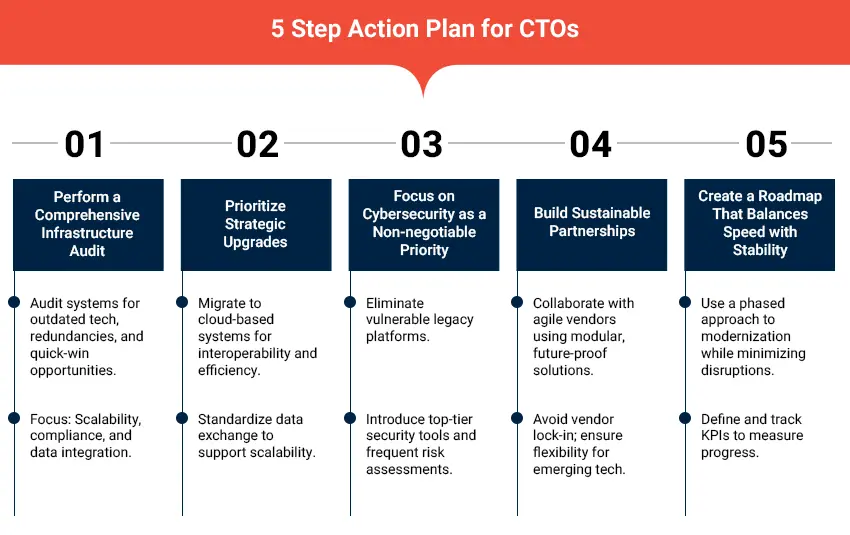January 24, 2025 - by Synoptek
Large amount of healthcare data, increased cyber threats, and reliance on old systems -all create technical debt. The slow pace of adopting changes adds to this problem. Globally, healthcare CTOs are working hard to fix technical debt. This issue affects how well technical updates match the organization’s goals, patient care, and rules.
Healthcare organizations face great pressure to innovate and follow strict rules like HIPAA. They struggle with old systems, limited resources, and outdated infrastructure. These issues make it hard to achieve innovation and interoperability and hinder long-term growth and scalability.
Stretched budgets lead organizations to extend the life of their hardware and software, sometimes seeking an additional three to five years of use. While maximizing existing technology, particularly critical systems like electronic health records (EHR), is understandable, it raises concerns.
Older systems are more susceptible to ransomware attacks, highlighting the risks of relying on outdated technology in a highly targeted cyber threat market. Last year was the worst-ever year regarding breached healthcare records, which jumped 9.4% from the previous year’s record-breaking total to 184,111,469 breached records, or 53% of the 2024 United States population.
The spiraling costs associated with maintaining outdated storage systems contribute to a cycle of technical debt that ultimately affects consumers through increased healthcare expenses.
Additionally, the complexity of managing technical debt in healthcare is worsened by the necessity for stringent data management practices, making it critical for healthcare technology leaders to confront these challenges directly.
Source: Cost of a Data Breach Report 2024
Consequences of Ignoring Tech Debt at the CTO Level
Ignoring technical debt can have serious implications for healthcare organizations. As technology evolves, the failure to address technical debt leads to:
Limited Ability to Support Next-gen Technologies Like AI, IoMT, and Advanced Data Analytics
Organizations burdened by technical debt struggle to integrate innovative technologies such as artificial intelligence and the Internet of Medical Things (IoMT). CTOs not on top of these trends cannot explore the full potential of data analytics, which is crucial for improving patient outcomes and operational efficiency.
Growing Costs of Maintaining Outdated Systems and Lack of Scalable Infrastructure
The financial burden of sustaining legacy systems can escalate quickly, diverting funds from essential projects. Healthcare organizations may find it increasingly difficult to adapt to changing demands or expand their services without a scalable infrastructure.
Sluggish Workflows, Reduced Productivity, and Longer Implementation Timelines for New Tech
Rigid systems, lack of flexibility, and increased maintenance burdens slow down processes and decrease productivity. Consequently, implementing new technologies takes longer, delaying potential improvements in patient care and operational capabilities.
Falling Behind Industry Competitors Who are Leapfrogging by Investing in Modern Platforms
As competitors invest in modern platforms and technologies, healthcare providers that ignore their technical debt risk falling behind. This gap puts laggard organizations behind the curve, losing market share and diminished relevance and reputation.
How do organizations get to this point? Charles Betz, VP Principal Analyst at Forrester, believes that technical debt is death by a thousand cuts, highlighting the top three reasons:
Why Breaking Free from Tech Debt is a CTO Priority
To become more agile, managing technical debt should be a consistent priority and the best way to drive infrastructure modernization. Breaking free from tech debt helps CTOs in:
Driving Digital Transformation
Build a robust foundation for integrating advanced technologies like telehealth and AI-powered diagnostics, which are crucial for improving patient care.
Protecting Organizational Security
Modernize outdated systems to reduce exposure to cybersecurity risks. Resolving technical debt will help to strengthen security posture, improve compliance levels, and better protect sensitive data.
Maintaining Interoperability Standards
Make it easy for different systems to communicate effectively. Ensure smoother data flow across multi-system environments, enhancing collaboration and improving patient outcomes.
Enabling Innovation
Adopt cutting-edge technologies more readily and accelerate research and development cycles in biotech and medical device sectors, keeping organizations competitive.
Future-Proofing Healthcare Innovation
If you’re a healthcare CTO looking to future-proofing healthcare innovation, you will need to put razor-sharp focus on:
Adopting Agile Methodologies
Embrace agility in technology deployment to respond quickly to changing requirements and implement solutions more efficiently. Agile practices facilitate iterative development, enabling teams to adjust based on real-time feedback.
Leveraging Data Analytics and AI
Leverage data analytics for informed decision-making and AI applications to enhance predictive analytics and patient care. Improve patient outcomes through personalized treatment plans and streamlined operations.
Enhancing Interoperability
Seamless data exchange between systems is vital for effective patient care. Implement strategies for seamless data exchange between systems to improve interoperability across platforms for better access to comprehensive patient information.
Pave the Way to Healthier ‘Care’ by Curing Technical Debt
By adopting hyper-converged infrastructure and healthcare managed services, healthcare organizations can achieve immediate security benefits, enhance application performance, and simplify IT management.
Modern hardware and operating systems inherently offer more substantial security features, supported by automated updates that reduce vulnerabilities. Consolidating storage, servers, and networking into a single platform minimizes attack vectors and streamlines support, enabling a reduction in tech debt.
Examples like IV pumps show that modern infrastructure ensures that devices operate securely and within trusted parameters. Embracing these innovations empowers healthcare IT teams to build a robust, secure, and efficient environment, ultimately improving outcomes for organizations and patients. Investing in a modern, secure infrastructure to manage technical debt is no longer optional—it’s essential.






